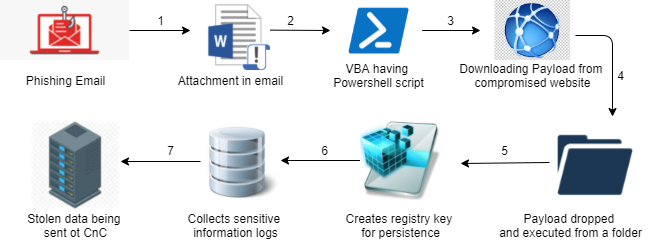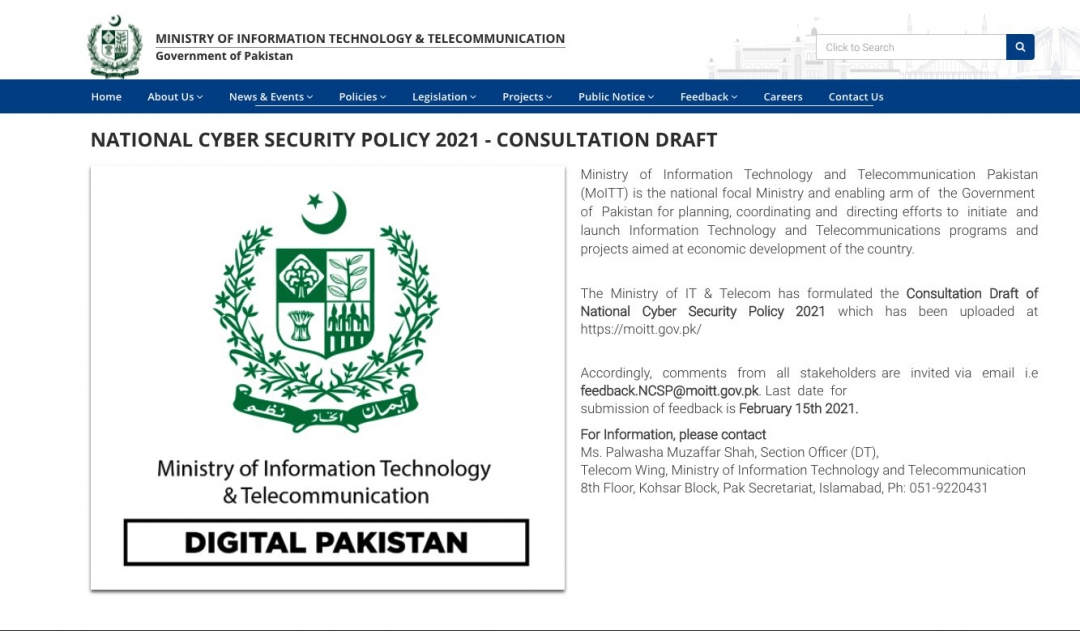The Zscaler ThreatLabz team has observed an interesting spear phishing campaign beginning July 2021 in which a threat actor is targeting a wide range of organizations in Pakistan. NetwiredRC is being used as the final payload in this attack campaign. The combination of spear phishing and the use of information stealing RAT indicates that this is not a simple cyber crime, but a larger cyberattack campaign targeting multiple government organizations in Pakistan along with other industry verticals.
Attack Cycle

Figure 1: Attack chain
Key features of this attack
- The attack has targeted multiple Pakistani government organizations using spear phishing emails.
- Lures use email info stolen from the actual website of the Pakistan government (Ministry of Information technology and telecommunication).
- The attack downloads its payload from the compromised website of the National College of Nepal located in Kathmandu.
- NetwireRAT, a well-known malware for stealing sensitive information, is being used as the final payload in the attack.
- Stolen information is sent using a proxy server in obfuscated form using the api WinHttpGetIEProxyConfigForCurrentUser() to command and control server 66[.]42.43.177:443
One of the latest spearphishing emails was sent from a spoofed email ID <feedback.ncsp@moitt.gov.pk> masquerading as “National Cyber Security Policy Feedback,” impersonating a government account which may be known by the target. During analysis, we found that the originating IP of the email is 209[.]58.188.82 which belongs to Hong Kong and has been reported for multiple phishing attacks in the past.
Figure 2: Spoofed email from <feedback.ncsp@moitt.gov.pk>
The email was sent on Wednesday, June 30, 2021 10:44 AM (PKT) with the subject “Cyber Security Policy Consultation Draft Final Update” to lure the recipients into opening an attached file named “NSCP-DRAFT-Final.docm”. The mail body contained information on the latest updates of the National Cyber Security Policy Draft along with the signature of a senior official to make the email look more professional and genuine.
Upon further research, it seems that the email info has been copied from the Ministry of Information Technology & Telecommunication site.
Figure 3: Email info from MoITT site.
Digging into the message source of the email, we can see that the spearphishing email is targeting users from a number of different industry verticals.
Figure 4: Originating IP and recipient email IDs from Message Source
Looking at the Email ID of multiple users, we can see that multiple sectors are being targeted by the threat actor, including Energy, Agricultural, Chemicals, Educational, Telecommunication and Financial Sectors, among others.
Distribution Strategy
We have observed multiple documents being delivered in various spearphishing attacks. All the documents have exactly the same macro content with the same URL to download the final payload.
1.) The first document we analyzed has a macro code containing a PowerShell script to download the final payload and execute it.
MD5 Hash: 22DF783F7881A7F6973028E21CA19D4F
File Name: NSCP-DRAFT-Final.docm
Figure 5: Attached .Docm file prompts the user to enable macros
2.) The second document we analyzed has a different title and slightly different text, but is otherwise extremely similar to the first document, and also has a macro code containing a PowerShell script to download the final payload and execute it.
MD5 Hash: AB5DAC030DC5FC9ED802C0322168558B
File Name: SCO-Cyber-Advisory.docm
Figure 6: Another malicious .docm file
3.) The third document we analyzed is also very similar to the first two instances. It contains a macro code containing a PowerShell script to download the final payload and execute it. The content displayed in this document masquerades as a lab handbook related to Institute of Space Technology (IST), Islamabad.
MD5 Hash: B6EC09770ED5B34922B0CF56CB17BC95
File Name: Press Note July-SCO.docm
Figure 7: Another similar .docm with a malicious macro
Technical Analysis of the macro
Once the document is opened, attackers try to trick the user by prompting them to enable macros to read the complete document. Once the user enables the macro, an AutoOpen() subroutine is called which then executes a malicious Visual Basic Application (VBA) macro with base-64 encoded URL. The macro downloads the final payload and path to save and execute the payload with the help of a PowerShell command.
Figure 8: Macro code with base 64 encoded URL
The two functions performed by the macro code are:
a.) Download the payload from the given URL in the macro code.
b.) Save and execute the payload from the specified path in the macro code.
Upon decryption, we get the URL which seems to be a recently compromised website belonging to the National College of Nepal located in Kathmandu.
“hxxps://nationalcollege.edu[.]np/admin/assets/js/jquery/tiny/plugins/anchor/.anchor/sysWow64.exe”
Figure 9: Decrypted Macro code
File Path: <C:\Windows\System32\spool\drivers\color\sysWow64.exe>
Technical Analysis of the payload
Once PowerShell downloads the final payload (NetwiredRC), it copies itself to the above mentioned path from where it gets executed.
NetwireRAT is not a new malware/RAT on the surface. First seen in 2012, it attempts to steal victims' passwords, including login credentials, FTP credentials, credit card data etc. It claims to be available in all OS formats including MacOS, Android and Windows. NetWireRAT is believed to have been used by the Iranian Nation state sponsored group APT33/Elfin back in 2016.
Once executed on the victim’s machine, several anti-analysis techniques are used to protect it from analysis. This version of Netwire has recently been employed with new anti-analysis techniques in order to hinder its reversal. Earlier versions involved WinApi usage for anti-analysis tricks like using GetCursorPos(), ZwGetContextThread() to check mouse position and to check register status for breakpoints respectively. The below screenshot shows the usage of GetCursorPos() api as anti-trick in an older version.

Figure 10: Anti-Analysis technique used in older version of NetWire
In addition to this, the old NetWire malware also checked the registers status against soft breakpoints, as we can see in the above image. For example, the call 'eax' is the call to the API. If we put a breakpoint on that in the debugger, the byte is replaced with 0xCC. That value is checked by NetWire using ZwGetThreadContext() api as an anti-trick.
MD5 Hash: 60D234D54C25DCEF19A64DED3A587072
During our analysis, we found that the malware extracts malicious code into the memory and executes it to evade antivirus detection. During static analysis, we have found that the malware is using some important libraries such as WS2_32 library to perform network activity.
Figure 11: Import libraries of the malware
Debugging the malicious code, we have seen that the malware author has also employed string obfuscation as an anti-analysis trick as shown in figure:12.
Figure 12: Obfuscated String
Following decryption, we get the following API: “winHttpGetIEProxyConfigForCurrentUser”
This piece of code has a self-decryption routine where it allocates a new memory space and then decrypts the code.
Figure 13: Self-Decryption Routine
Persistence
After decryption, the malware assigns HostId randomly and adds it as a registry key.
Figure 14: Random HostID
key: HKEY_CURRENT_USER\Software\NETwIRe
name: HostId
key: HKEY_CURRENT_USER\Software\NETwIRe
name: Install Date
key: HKEY_CURRENT_USER\Software\Microsoft\Windows\CurrentVersion\Run
name: sysWOW32
Figure 15: Registry key for persistence.
Stealing functionality
This malware basically steals sensitive information from the victim's machine.
Figure 16: Stealing information
A sample of keystrokes logs in a file that is created in the %AppData% directory, which the malware stores in obfuscated form.

Figure 17: Keylogs in obfuscated form
Command and Control
Another thing related to network activity we observed in the new variant was that this new Netwire variant uses WinHttpGetIEProxyConfigForCurrentUser() api ,which retrieves the Internet Explorer proxy configuration for the current user in the system (adversaries use this feature as a network relay between the malware and the proxy server by listening over a certain port). This api retrieves the list of proxy servers in the system. It steals users' sensitive information and browser history stored in the browsers and sends it to the command and control server. During our analysis of the binary structure, we found the hardcoded IP address of the Command and Control server: 66[.]42.43.177.

Figure 18: Data to be sent using proxy
ThreatLabz observed that NetwireRAT malware sends the collected victim’s data using the proxy server in obfuscated form using the same api (which was decrypted above). This way of sending victims' data using a proxy server is a new feature being implemented in the updated version of NetWireRAT.
Config extracted from malware
{
"C2 list": [
"127.0.0.1:3360",
"66.42.43.177:443"
],
"Password": "Password",
"Host ID": "HostId-%Rand%",
"Mutex": "-",
"Install Path": "C:\\Windows\\System32\\spool\\drivers\\color",
"Startup Name": "sysWOW32",
"ActiveX Key": "-",
"KeyLog Directory": "-"
}
Cloud Sandbox Detection
Zscaler Cloud Sandbox successfully detects the malicious documents as well as the payload.
Figure 19: Zscaler Cloud Sandbox detection
In addition to sandbox detections, Zscaler’s multilayered cloud security platform detects indicators at various levels
Conclusion
Over the years, cyber criminals have adopted multiple ways to infect their victims with NetwiredRC and achieved lots of success. We are not conclusively attributing this attack to any particular group with high confidence, but similar techniques and NetwireRAT payloads have been utilized by state sponsored groups such as APT33 and Gorgon. Attackers continuously embrace new anti-analysis tricks to evade security solutions; re-packaging of malware makes static analysis even more challenging.
The Zscaler ThreatLabz team will continue to monitor this attack, as well as others, to help keep our customers safe.
MITRE ATT&CK TTP Mapping
| Tactic | Technique |
| T1547 | Boot Logon or AutoStart Execution |
| T1056 | Input Capture |
| T1036 | Masquerading |
| T1113 | Screen Capture |
| T1082 | System Information Discovery |
| T1055 | Process Hollowing |
| T1555 | Credentials From Web Browsers |
| T1074 | Data Staged: Local Data Staging |
Indicators of Compromise (IOC’s)
Doc files
22DF783F7881A7F6973028E21CA19D4F
AB5DAC030DC5FC9ED802C0322168558B
B6EC09770ED5B34922B0CF56CB17BC95
Payload
60D234D54C25DCEF19A64DED3A587072
715788FB520B3873DB406FDF59521AFA
026C1CE7E96A898C23A7CE9A567B9568
617E8CC54BB247091266826225553A25
CnC
66[.]42.43.177:443



















